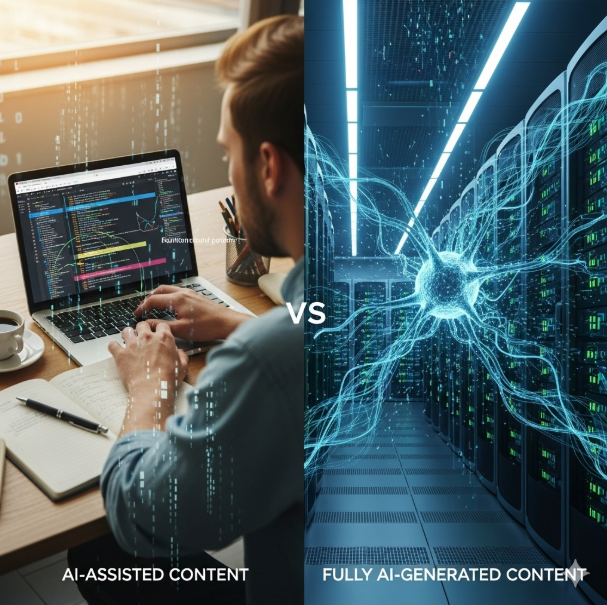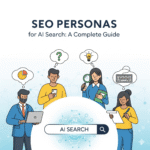Artificial intelligence has changed the way we create and consume content. But when people talk about using AI in writing, they often mix up two very different approaches: AI-assisted content and fully AI-generated content.
If you’re a business owner, marketer, or content creator, knowing the difference can save you from wasting time, hurting your brand, or missing out on real growth opportunities. Let’s break it down in a simple and practical way.
What Is AI-Assisted Content?
AI-assisted content is when you use AI tools to support, enhance, or speed up your writing process, but you still stay in control of the final output.
Think of it like this:
- AI is your assistant.
- You’re still the author.
You use AI to brainstorm, outline, suggest ideas, or polish grammar—but your expertise, creativity, and voice remain the backbone.
Examples of AI-assisted content tasks:
- Generating blog outlines
- Suggesting headlines or titles
- Rephrasing sentences for clarity
- Summarizing research quickly
- Creating draft social media captions that you edit
This approach combines human creativity + AI efficiency.
What Is Fully AI-Generated Content?
Fully AI-generated content means the AI does everything: from idea generation to writing the full article, with minimal or no human involvement.
Here, the content often sounds fluent and polished, but it may:
- Lack depth or unique insights
- Repeat generic information
- Miss context or accuracy
- Fail to match your brand’s personality
Basically, you get text that “looks right” on the surface but may not deliver the value your audience expects.
Examples of fully AI-generated content:
- Blog posts written 100% by AI with no edits
- Product descriptions copied directly from AI output
- Automated newsletters without human review
Why Does the Difference Matter?
AI tools are powerful, but how you use them decides whether they become a shortcut to growth or a trap that harms your credibility.
Here’s why the distinction is so important:
- Authenticity and Trust
- AI-assisted: Keeps your brand’s tone and personality.
- Fully AI: Risks sounding robotic or generic.
- Accuracy
- AI-assisted: You fact-check and refine.
- Fully AI: Higher risk of misinformation (AI hallucinations).
- SEO and AI Search
- AI-assisted: Rich, experience-backed content performs better.
- Fully AI: Generic text may not rank and can be filtered out by AI-driven search tools.
- User Experience
- AI-assisted: Content feels relatable and trustworthy.
- Fully AI: Users may leave if the content lacks depth.
Beneficial Pointers to Use AI-Assisted Content Wisely
Here are some practical ways to get the best out of AI without losing your originality:
1. Use AI for Research, Not Final Words
Let AI gather insights, summarize articles, or highlight trends but always validate before publishing.
2. Keep Your Voice Consistent
AI can draft sentences, but you should always add your unique tone, style, and examples. That’s what makes your content memorable.
3. Blend Human Stories With AI Structure
AI is great at structure. You’re great at storytelling. Combine both to create engaging and trustworthy content.
4. Treat AI as a Drafting Partner
Never copy-paste AI text as-is. Think of AI as your first draft writer then add your expertise, experiences, and adjustments.
5. Stay Updated on AI’s Role in SEO
Google and AI search engines increasingly prioritize helpful, authentic, people-first content. AI-assisted writing fits this model far better than fully automated text.
AI-Assisted Content vs Fully AI-Generated Content: Key Differences
| Factor | AI-Assisted Content ✅ | Fully AI-Generated Content ❌ |
|---|---|---|
| Control | Human stays in charge of tone, accuracy, and structure | AI controls the entire output with little to no human input |
| Quality | Higher—human creativity + AI efficiency | Variable—may look polished but often generic |
| Accuracy | Verified by humans, less risk of errors | Higher chance of AI “hallucinations” or false info |
| SEO Value | Stronger—content feels authentic, ranks better | Weaker—may be filtered out by AI search for being repetitive |
| Tone & Voice | Consistent with brand personality | Can sound robotic or too neutral |
| Use Cases | Blog posts, thought leadership, SEO guides, email campaigns | Bulk descriptions, brainstorming drafts, internal notes |
| Trust Factor | Builds credibility with audience | May reduce trust if content lacks depth |
When to Use AI-Assisted vs Fully AI-Generated
Let’s look at scenarios where each approach might fit:
- AI-Assisted Content Works Best For:
- Blog posts that need authority and expertise
- Thought-leadership articles
- SEO-focused guides
- Content where brand tone matters
- Fully AI-Generated Content Might Be Fine For:
- Internal drafts or brainstorming notes
- Simple product descriptions (with human review)
- Bulk content where uniqueness isn’t critical
Realistic Example
Imagine you’re writing a blog on “Top SEO Strategies for Architects.”
- AI-Assisted Version:
You ask AI to suggest an outline, gather key SEO points, and draft some headlines. Then, you add your own insights, case studies, and practical tips based on experience. - Fully AI-Generated Version:
You ask AI to write the full blog in one go. The result may look okay but lacks real-world examples and might repeat surface-level tips like “use keywords” or “optimize meta tags.”
Which one do you think your audience will trust more? Clearly, the AI-assisted one.
Key Takeaways
- AI-assisted content = partnership between human and AI, keeping quality and authenticity intact.
- Fully AI-generated content = fast but risky, often generic and less trustworthy.
- For long-term success, AI-assisted content is the smarter choice, especially in SEO and marketing.
Final Word
The future of content isn’t about replacing humans it’s about enhancing human creativity with AI. If you rely only on fully AI-generated content, you risk sounding like everyone else. But if you use AI to assist, you’ll produce faster, sharper, and more engaging content that actually connects with people.
In short: AI should be your co-pilot, not the driver.
GET IN TOUCH
Ready to Create Smarter Content?
Most SEO agencies will promise you the world in 30 days. I won’t.
What I will do is spend 30 minutes looking at your website and telling you exactly what’s broken, what’s working, and what you need to focus on first. No sugar-coating, no false promises.
I help businesses use AI-assisted content strategies that balance speed with authenticity so your brand stands out without losing its voice.
Discover more from PratsDigital
Subscribe to get the latest posts sent to your email.



Pingback: Tools for Analyzing Featured Snippet Performance in AI-Generated Answers - PratsDigital
Pingback: Most Profitable eCommerce Niches (2026): The Niches I Would Pick If I Were Starting Today - PratsDigital